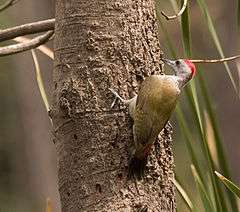African grey woodpecker
| African grey woodpecker | |
|---|---|
 | |
| Scientific classification | |
| Kingdom: | Animalia |
| Phylum: | Chordata |
| Class: | Aves |
| Order: | Piciformes |
| Family: | Picidae |
| Genus: | Dendropicos |
| Species: | D. goertae |
| Binomial name | |
| Dendropicos goertae (Statius Muller, 1776) | |
The African grey woodpecker (Dendropicos goertae) is a species of bird in the family Picidae.[2][3] Is a widespread and frequently common resident breeder in much of Sub-Saharan and equatorial Africa. It is a species associated with forest and bush which nests in a tree hole, often in an oil palm, laying two to four eggs.[4] It is a common bird with a very wide range, and the International Union for Conservation of Nature has rated its conservation status as being of "least concern".[1]
Description
Like other woodpeckers, this species has a straight pointed bill, a stiff tail to provide support against tree trunks, and zygodactyl or “yoked" feet, with two toes pointing forward, and two backward. The long tongue can be darted forward to capture insects. This bird is 20 cm (7.9 in) in length. It is a typical woodpecker shape, and has unmarked green upperparts and a pale grey head and underparts. The rump is red, and there is a small red belly patch. The short tail is blackish. The adult male grey woodpecker has a red crown. Females have a plain grey head, lacking the red crown. Young birds are like the female, but the reds are paler, and there may be some flank barring.[5]
Distribution and habitat
The African grey woodpecker is native to tropical parts of western and central Africa. Its range includes Angola, Benin, Burkina Faso, Burundi, Cameroon, Central African Republic, Chad, Congo, Democratic Republic of Congo, Equatorial Guinea, Eritrea, Ethiopia, Gabon, Gambia, Ghana, Guinea, Guinea-Bissau, Ivory Coast, Kenya, Liberia, Mali, Mauritania, Niger, Nigeria, Rwanda, Senegal, Sierra Leone, South Sudan, Sudan, Tanzania, Togo and Uganda.[1] Its typical habitat includes woodland, savannah with isolated trees, copses of larger trees, riverside forest and pasture.[4]
Ecology
Like other woodpeckers, this species is an insectivore. It is frequently seen, and regularly taps or drums. The call is a loud and fast peet-peet-peet-peet. This species and the eastern grey woodpecker (Dendropicos spodocephalus) were formerly considered conspecific.[4]
References
- 1 2 3 BirdLife International (2014). "Dendropicos goertae". IUCN Red List of Threatened Species. Version 2015.4. International Union for Conservation of Nature. Retrieved 20 January 2016.
- ↑ Gill, Frank; Donsker, David (eds.). "Woodpeckers". World Bird List Version 5.4. International Ornithologists' Union. Retrieved 20 January 2016.
- ↑ Fuchs, J.; Pons, J.M. (2015). "A new classification of the pied woodpeckers assemblage (Dendropicini, Picidae) based on a comprehensive multi-locus phylogeny". Molecular Phylogenetics and Evolution. 88: 28–37. PMID 25818851. doi:10.1016/j.ympev.2015.03.016.
- 1 2 3 Winkler, H.; Christie, D.A. "Grey woodpecker (Dendropicos goertae)". Handbook of the Birds of the World Alive. Lynx Edicions, Barcelona. Retrieved 12 November 2016.
- ↑ Hans Winkler; David A. Christie (2010). Woodpeckers. Bloomsbury Publishing. p. 84. ISBN 978-1-4081-3504-4.
- Birds of The Gambia by Barlow, Wacher and Disley, ISBN 1-873403-32-1
- Grey Woodpecker - BirdLife Species Factsheet, Bird Life International
